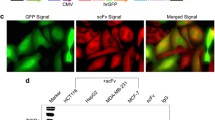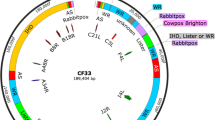Abstract
ras mutations represent one of the most common oncogenetic lesions in human non-small cell lung cancer (NSCLC) and adversely affect the survival of patients afflicted with this disease. ras-directed gene therapy in the past employed primarily antisense oligonucleotides (AS-ODN) or expression vectors (such as a viral vector construct) that deliver the antisense sequence to inactivate the mutant oncogene message. These approaches produced minimal toxicity, and yet were limited in efficacy. Ribozymes present a viable alternative in antisense therapy by virtue of their renewable catalytic capability for site-specific RNA cleavage. We recently produced an adenoviral vector with a hammerhead ribozyme transgene (KRbz) that is specific for the K-ras codon 12 mutant sequence GUU, given the considerations that (a) in the United States, approx 30% of human NSCLCs express K-ras oncogene mutations, nearly all of which reside in codon 12; (b) anti-K-ras, anti-H, as well as anti-N-ras hammerhead ribozymes are potent growth inhibitors in various human cancers tested; and (c) in vitro and animal model studies suggest that ribozymes directed at oncogene (K- and H-ras C-fos, BCR-ABL) or human immunodeficiency viral gene messages are more effective than their antisense counterpart. This article describes the techniques involved in the production of the KRbz-adenoviral vector that is specific for the K-ras mutation GTT, and summarizes its in vivo antitumor effect against NSCLC xenografts expressing the relevant K-ras mutation in athymic mice.
Similar content being viewed by others
References
Rodenhuis, S. (1996) RAS oncogenes and human lung cancer in Lung Cancer: Principles and Practice (Pass H.I., Mitchell J.B., Johnson D.H., Turrisi A.T. eds.), Lippincott-Raven, Philadelphia, PA, pp 73–82.
McCormick, F. (1993) Signal transduction: How receptors turn ras on. Nature 363, 15–16.
Sun, J., Qian, Y., Hamilton, A.D., and Sebti, S.M. (1995) Ras CAAX peptidomimetic FTI 276 selectively blocks tumor growth in nude mice of a human lung carcinoma with K-ras mutation and p53 deletion. Cancer Res. 55, 4243–4247.
Campbell, S.L., Khosravi-Far, R., Rossman, K.L., Clark, G.J., and Der, C.J. (1998) Increasing complexity of Ras signaling. Oncogene 17, 1395–1413.
Zohn, I.M., Campbell, S.L., Khosravi-Far, R., Rossman, K.L., and Der, C.J. (1998) Rho family proteins and Ras transformation: the RHOad less traveled gets congested. Oncogene 17, 1415–1438.
Downward, J. (1998) Ras signalling and apoptosis. Curr. Opin. Genet. Dev. 8, 49–54.
Chou, C.C. and Yung, B.Y. (1997) Antiapoptotic effect of ras in the apoptosis induced by serum deprivation and exposure to actinomycin D. Naunyn-Schmiedebergs Arch. of Pharmacol. 355, 177–182.
Ward, R.L., Todd, A.V., Santiago, F., O’Connor, T., and Hawkins, N. J. (1997) Activation of the K-ras oncogene in colorectal neoplasms is associated with decreased apoptosis. Cancer 79, 1106–1113.
Irani, K., Xia, Y., Zweier, J.L., Sollott, S.J., Der, C.J., Fearon, E.R., Sundaresan, M., Finkel, T., and Goldschmidt-Clermont, P.J. (1997) Mitogenic signaling mediated by oxidants in ras-transformed fibroblasts. Science 275, 1649–1652.
Rak, J., Filmus, J., Finkenzeller, G., Grugel, S., Marme, D., and Kerbel, R. S. (1995) Oncogenes as inducers of tumor angiogenesis. Cancer Metastasis Rev. 14, 263–277.
Okada, F., Rak, J.W., Croix, B.S., Lieubeau, B., Kaya, M., Roncari, L., Shirasawa, S., Sasazuki, T., and Kerbel, R.S. (1998) Impact of oncogenes in tumor angiogenesis: mutant K-ras up-regulation of vascular endothelial growth factor/vascular permeability factor is necessary, but not sufficient for tumorigenicity of human colorectal carcinoma cells. Proc. Natl. Acad. Sci. USA. 95, 3609–3614.
Lowy, D.R., and Willumsen, B.M. (1995) Rational cancer therapy. Nature Med. 1, 747–748.
Cochet, O., Kenigsberg, M., Delumeau, I., Virone-Oddos, A., Multon, M. C., Fridman, W. H., Schweighoffer, F., Teillaud, J. L., and Tocque, B. (1998) Intracellular expression of an antibody fragment neutralizing p21 ras promotes tumor regression. Cancer Res. 58, 1170–1176.
Chang, E.H., Miller, P.S., Cushman, C., Devadas, K., Pirollo, K.F., Ts’o, P.O.,and Yu, Z.P. (1991) Antisense inhibition of ras p21 expression that is sensitive to a point mutation. Biochemistry 30, 8283–8286.
Tidd, D.M. (1990) A potential role for antisense oligonucleotide analogues in the development of oncogene-targeted cancer chemotherapy. Anti-Cancer Res. 10, 1169–1182.
Zhang, Y., Mukhopadhyay, T., Donehower, L.A., Georges, R.N., and Roth, J.A. (1993) Retroviral vector-mediated transduction of K-ras antisense RNA into human lung cancer cells inhibits expression of the malignant phenotype. Human Gene Ther. 4, 451–460.
Georges, R.N., Mukhopadhyay, T., Zhang, Y., Yen, N., and Roth, J.A. (1993) Prevention of orthotopic human lung cancer growth by intratracheal instillation of a retroviral antisense K-ras construct. Cancer Res. 53, 1743–1746.
Cech, T.R. (1990) Self-splicing of Group I introns. Ann. Rev. Biochem. 59, 543–568.
Kijima, H., Ishida, H., Ohkawa, T., Kashani-Sabet, M., and Scanlon, K.J. (1995) Therapeutic applications of ribozymes. Pharmacol. Therap. 68, 247–267.
Cech, T.R. and Uhlenbeck, O.C. (1994) Hammerhead nailed down. Nature, 372, 39–40.
Koizumi, M., Kamiya, H., and Ohtsuka, E. (1992) Ribozyme designed to inhibit transformation of NIH3T3 cells by the activated c-Ha-ras gene. Gene 117, 179–184.
Bennett, M.J., and Cullimore, J.V. (1992) Selective cleavage of closely related mRNAs by synthetic ribozymes. Nuc. Acids Res. 20, 831–837.
Haseloff, J., and Gerlach, W.L. (1988) Simple RNA enzymes with new and highly specific endoribonuclease activities. Nature 334, 585–591.
Ruffner, D.E., Stormo, G.D., and Uhlenbeck, O.C. (1990) Sequence requirements of the hammerhead RNA self-cleavage reaction. Biochemistry 29, 10,695–10,702.
Funato, T., Shitara, T., Tone, T., Jiao, Lu, Kashani-Sabet, M., and Scanlon, K.J. (1994) Suppression of H-ras-mediated transformation in NIH3T3 cells by a ras ribozyme. Biochem. Pharmacol. 48, 1471–1475.
Feng, M., Cabrera G., Desane, J., Scanlon, K.J., and Curiel, D.T. (1995) Neoplastic reversion accomplished by high efficiency adenoviral-mediated delivery of an anti-ras ribozyme. Cancer Res. 55, 2024–2028.
Kashani-Sabet, M., and Scanlon K.J. (1995) Application of ribozymes to cancer gene therapy. Cancer Gene Ther. 2, 213–223.
Strauss, G.M., Kwiatkowski, D.J., Harpole, D.H., Lynch, T.J., Skarin, A.T., and Sugarbaker, D.J. (1995) Molecular and pathologic markers in stage I non-small-cell carcinoma of the lung. J. Clin. Oncol. 13, 1265–1279.
Zhang, Y., Nemunaitis, J., Mues, G., Scanlon, K.J., and Tong, A.W. (1996) In vitro suppression of human non-small cell lung cancer (NSCLC) cell growth by an anti-K-ras ribozyme (Abstract). FASEB J. 10, A1409.
Nemunaitis, J., Klemow, S., Tong, A., Courtney, A., Johnston, W., Mack, M., Taylor, W., Solano, M., Stone, M., Mallams, J., and Mues, G. (1998) Prognostic value of ras mutations, ras oncoprotein and c-erb B-2 oncoprotein expression in adenocarcinoma of the lung. Am. J. Clin. Oncol. 21, 155–160.
Ohta, Y., Kijima, H., Kashani-Sabet, M., and Scanlon, K.J. (1996) Suppression of the malignant phenotype of melanoma cells by anti-oncogene ribozymes. J. Invest. Dermatol. 106, 275–280.
Kijima, H., Bouffard, D.Y., and Scanlon, K.J. (1996) Ribozyme-mediated reversal of human pancreatic carcinoma phenotype, in Proceedings of International Symposium on Bone Marrow Transplantation (Ikehara S. ed.), Verlag-Springer, Tokyo, pp. 153–163.
Campain, J.A., Matassa, A.A., Felgner, P.L., Barnhart, K.M., Curiel, D.T., and Harrison, G.S. (1998) Lipid- and adenoviral-mediated gene transfer into AIDS-Kaposi’s sarcoma cell lines. Cancer Gene Ther. 5, 131–143.
Felgner, P.L. (1997) Nonviral strategies for gene therapy. Sci. Am. 276, 102–106.
Gunning, P., Leavitt, J., Muscat, G., Ng, S.Y., and Kedes, L. (1987) A human β-actin expression vector system directs high-level accumulation of antisense transcripts. Proc. Natl. Acad. Sci. USA 84, 4831–4835.
Larrson, S., Hotchkiss, G., Andang, M., Nyholm, T., Inzunza, J., Jansoon, I., and Ahrlund-Richter, L. (1994) Reduced β2-microglobulin mRNA levels in transgenic mice expressing a designed hammerhead ribozyme. Nuclei Acids Res. 22, 2242–2248.
Tong, A.W., Zhang, Y.A., Scanlon, K.J., and Nemunaitis, J. (1998) Anti-tumorigenic effect of a recombinant anti-K-ras ribozyme adenoviral vector on human non-small cell lung cancer (NSCLC) xenografts. In Proceedings of the 7th International Conference on Gene Therapy of Cancer, San Diego, CA, 1998.
Zhang, Y.A., Nemunaitis, J., Scanlon, K.J, and Tong A.W. (1999) Anti-tumorigenic effect of a K-ras ribozyme against human lung cancer cell line heterotransplants in nude mice, submitted.
Sambrook, J., Fritsch, E. F., and Maniatis, T. (1989) DNA sequencing in, Molecular Cloning: A Laboratory Manual, 2nd ed., (Ford N., Nolan C., and Ferguson M. eds.) Cold Spring Harbor Laboratory Press, Cold Spring Harbor, NY, pp. 13.42–13.77.
Becker, T.C., Noel, R.J., Coats, W.S., Gomez-Foix, A.M., Alam, T., Gerard, R.D., and Newgard, C.B. (1994) Use of recombinant adenovirus for metabolic engineering of mammalian cells. Methods Cell Biol. 43, 161–189.
Graham, F.L. and Prevec, L. (1991) Manipulation of adenovirus vectors in Methods in Molecular Biology, vol. 7: Gene Transfer and Expression Protocols, Murray E.G., ed. pp. 109–128. Humana, Totowa, NJ, pp. 109—128.
Author information
Authors and Affiliations
Corresponding author
Rights and permissions
About this article
Cite this article
Zhang, YA., Nemunaitis, J. & Tong, A.W. Generation of ribozyme-adenoviral vector against K-ras mutant human lung cancer cells. Mol Biotechnol 15, 39–49 (2000). https://doi.org/10.1385/MB:15:1:39
Issue Date:
DOI: https://doi.org/10.1385/MB:15:1:39




